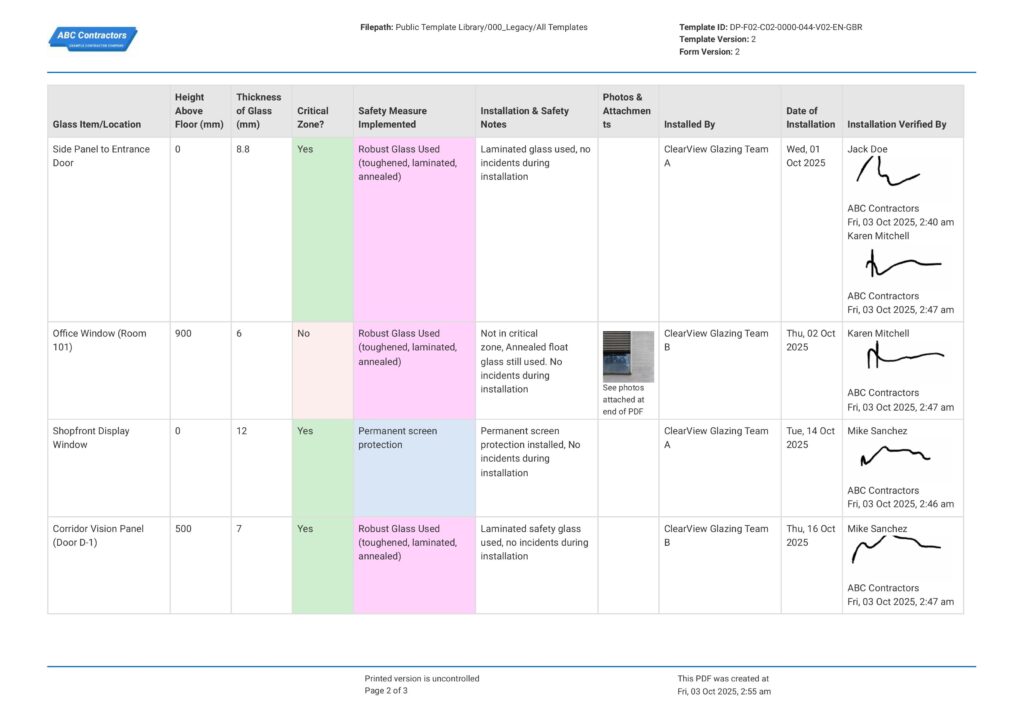Glazing Safety Log Template
Start with a free 30-day trial. No credit card required.

~10,000 employees
~500 employees
~10 employees
~25,000 employees
~200 employees
~1,500 employees
~20 employees
What is a Glazing Safety Log?
A Glazing Safety Log is a document engineers and installers use to record details on installation and safety measures for glass installation tasks. In the UK, it is usually done to demonstrate compliance with regulations set forth in the Approved Document K PDF. Specifically, these regulations mainly focus on safety measures when installing glass panels in "critical zones ", or where impacts with glass panels are more likely to occur during installation.
Primarily, a glazing safety log serves to provide a paper-trail for safety audits and investigations from the local safety regulatory body. A glazing safety log would normally include details on the type of glass, its location, its purpose (door, window, panel, partition, etc.), whether or not it is considered in a critical zone, safety measures performed, and other installation details. Ideally, this information should fit in a table, where data across installation tasks can easily be gleaned and verified by the inspecting engineers.
Compare this Glazing Safety Log with other legacy formats (Word, Excel)
Use this Glazing Safety Log template for free.
What is Glazing in Construction?
In the context of construction, glazing refers to the process of installing glass panels to serve as windows, doors, facades, partitions, and other building elements. Additionally, glazing is also a noun that refers to the glass that is fitted to the frame itself. The term “glazing” comes from the word “glace”, which is a word to describe a smooth, glossy surface.
Modern building design and aesthetic have given rise to the increased use of glass and glass panels to serve anywhere between doors and curtain walls. Glass panels are highly valued as a design element, as it allows a lot of natural lighting into rooms and spaces. Now, you can see glass walls, doors, and partitions in almost every office building around the world.
Why is Glazing Safety Important?
Glazing Safety is important because, no matter the application, glass is still fragile to breaking when handled or installed incorrectly. According to Part K, or the Approved Document K, impacts with glazing have shown to cause cutting and piercing injuries. Hands, wrists, and arms are noted to be particularly vulnerable. Further, impact between waist and shoulder levels can be followed by a fall through the glazing itself, resulting in further injury.
It is important to note that in the Approved Document K Wales, it is stated that regions of glazing installed within a certain distance from the floor line is more likely to cause injury to installers and others. This region is known as the “critical zone”. Further, in order to reduce the likelihood of injuries when working with glazing in critical zones, Part K also notes safety measures that installers are required to perform.
What is Required for Glazing Safety?
According to the Approved Document F, the requirement as to the protection against impact with glazing is the following:
“Glazing, with which people are likely to come into contact whilst moving in or about the building shall:
- If broken on impact, break in a way that is unlikely to cause impact
- Resist impact without breaking
- Be shielded or protected against impact”
Additionally, it is stated in Part K that installers can meet these requirements if they adopt, in critical zones, one of the following approaches:
- Measures to limit the risk of cutting and piercing injuries by the use of glazing that is reasonably safe, such that, if breakage did occur, any particles would be relatively harmless.
- Use of glazing sufficiently robust to ensure that the risk of breakage is low.
- Steps are taken to limit the risk of contact with the glazing.
Finally, the Approved Document goes on to require installers dealing with critical zones to either ensure safe breaking of the glazing, use robust glazing, glazing in small panes, or provide permanent protection for the glazing.
Frequently Asked Questions
Why should I use this Glazing Safety Log over other formats?
With Sitemate’s Glazing Safety Log template, you can easily create forms to document all aspects of all your glazing installation tasks and perform a sign off on each. Plus, you can even add your installation notes and attach photos for every installation, to ensure all documentation is present and easily accessible.
Does this Glazing Safety Log comply with building regulations?
Yes, this Glazing Safety Log was built entirely on the regulations set in Part K, or the Approved Document K, of the UK Building Regulations, to help you and your team ensure compliance.
Can I edit some portions of the log template for my company’s needs?
Yes, with Dashpivot’s intuitive drag-and-drop template builder, you can easily add, remove, or change any portion of the safety log template to suit your company’s needs. You can even add your company logo and custom letterhead when you're done.
How do I access the logs I create?
You can access all the logs you create on any device - phone, tablet, laptop, computer. This means that you can stay dynamic and fill-out the log on your phone, save and access it later on your computer for edits and sign-offs.
Other popular templates you can use and edit for free

Glazing Safe Work Method Statement
Make sure your team stays safe when working with glazing and glass installations by listing down important safe work methods

Manufacturing Safety Audit Checklist
Demonstrate compliance with manufacturing regulations and stay on top of audits and investigations with this template

Damage Assessment Report
Ensure proper documentation of any damage or loss to your property at the jobsite
This log was generated with Dashpivot software
More and more construction companies are leaning away from paper-centric work-flows and towards the ease that digital tools like Dashpivot provide.
- Access, edit and complete glazing safety logs from any device - mobile, tablet or computer.
- Print, download or send your safety logs as perfectly formatted PDF documents with your company logo.
- Store your logs securely online, where they can be searched and found in seconds
- Invite internal and external parties to see, edit and sign off on logs online.
Sitemate builds best-in-class software tools for built world companies.


